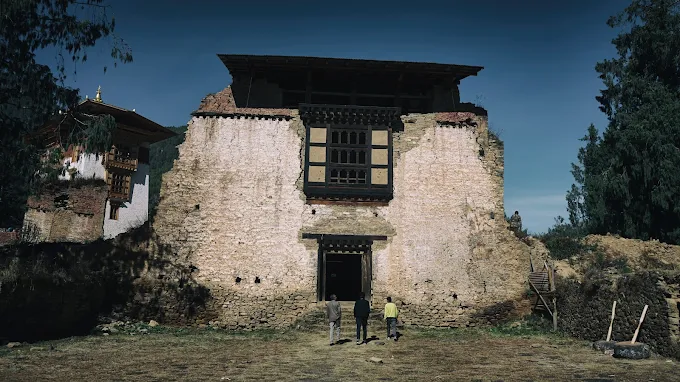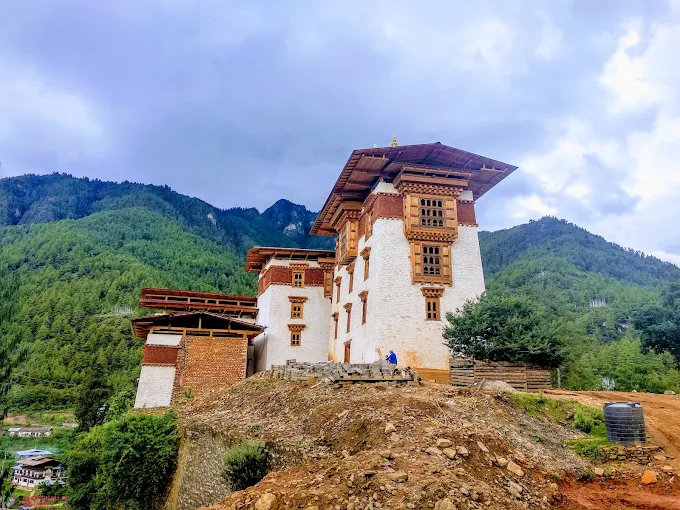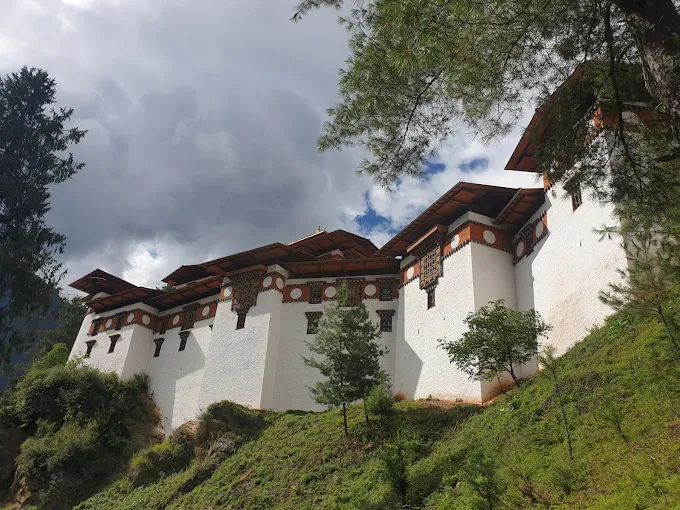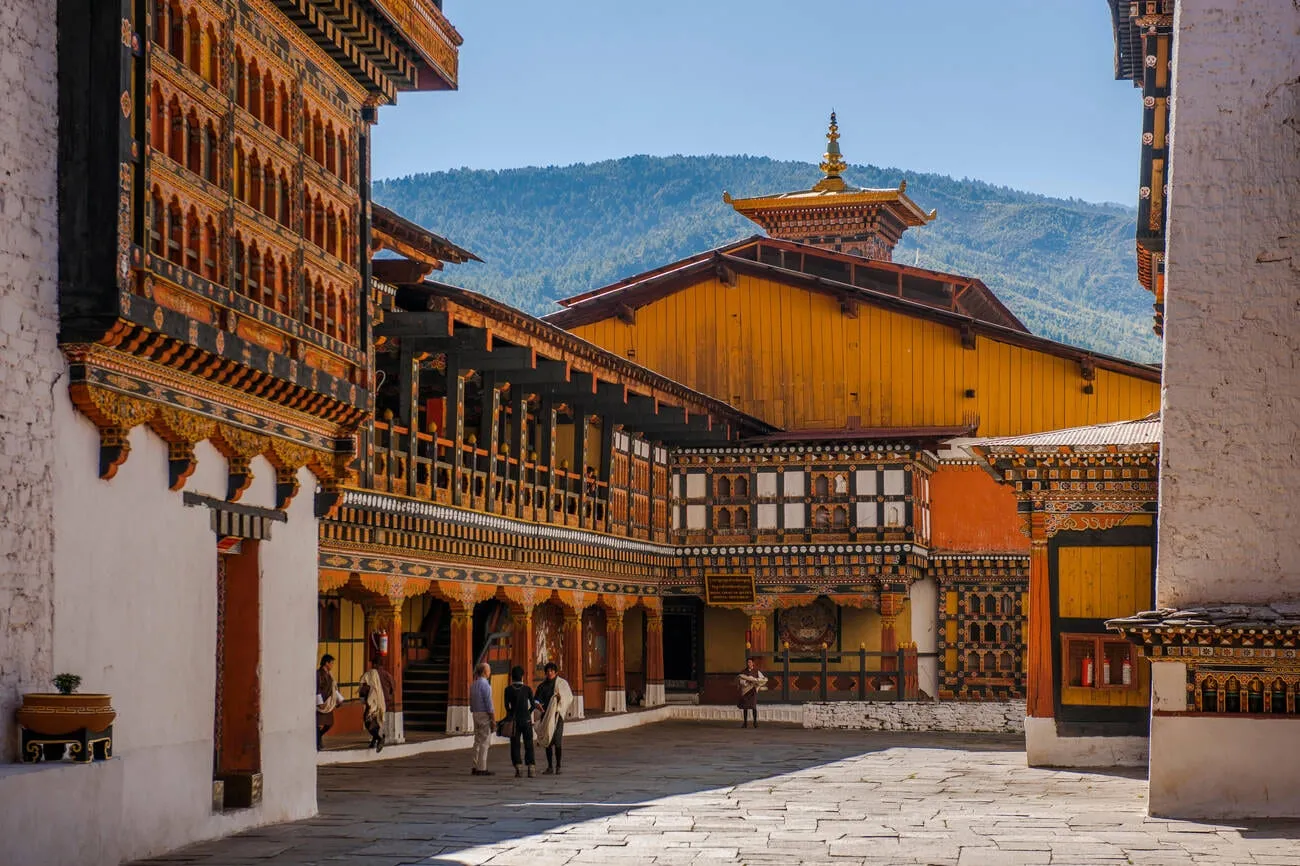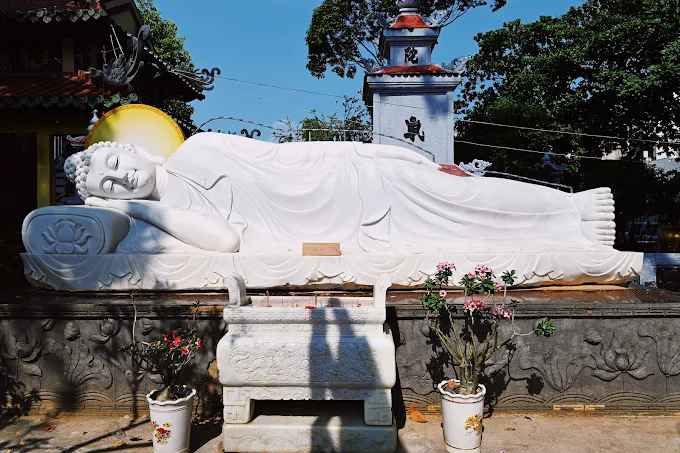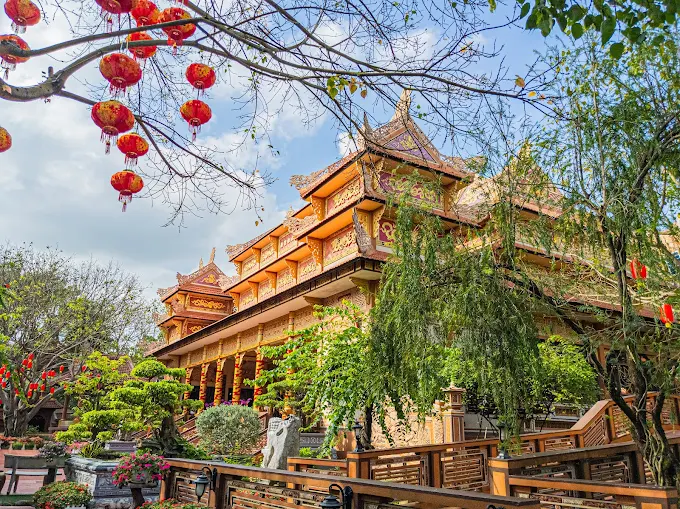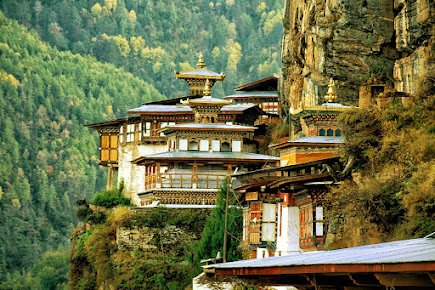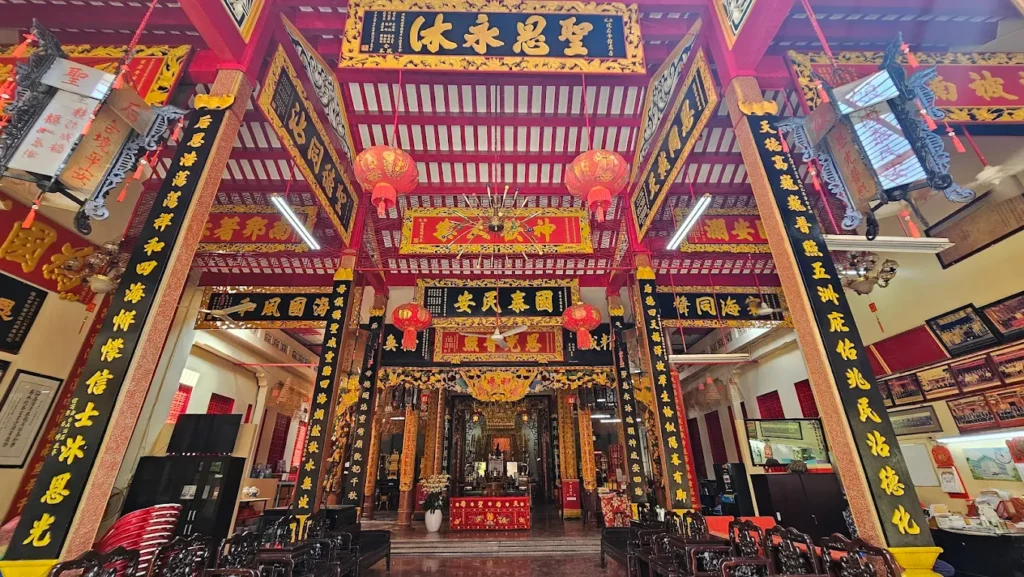Drukgyel Dzong: The Ruined Bastion of Victory
Overview and Significance
Essence of Drukgyel Dzong
Drukgyel Dzong, perched at the northern end of Bhutan’s Paro Valley, stands as a weathered monument to triumph, its crumbling walls whispering tales of 17th-century victories. Built in 1649 to commemorate Bhutan’s defeat of Tibetan invaders, this fortress-monastery once gleamed with strategic might, its name meaning “Fortress of the Victorious Drukpa.” Though reduced to ruins by a 1951 fire, its stark silhouette against the Jomolhari peak captivates visitors, evoking a sense of resilience and reverence. Drukgyel Dzong is a poignant reminder of Bhutan’s martial and spiritual heritage, drawing those who seek history’s echoes in its silent stones.
- Defining Trait: A ruined fortress celebrating Bhutan’s victory over Tibetan forces.
- Spiritual Role: A former monastic center, now a site of historical pilgrimage.
- Visitor Appeal: A haunting ruin for explorers and history enthusiasts.
Unlike Paro’s intact dzongs, Drukgyel’s decay adds a layer of mystique, its broken ramparts framed by snow-capped peaks. The site’s isolation, surrounded by rice fields and pine forests, fosters quiet reflection, while its proximity to Jomolhari ties it to Bhutan’s sacred geography. For locals, it’s a symbol of national pride; for travelers, it’s a portal to a bygone era of heroism.
Historical Evolution
Drukgyel Dzong was erected in 1649 by Zhabdrung Ngawang Namgyal, Bhutan’s unifier, to guard the Paro Valley against Tibetan invasions. Strategically placed at a trade route’s mouth, it symbolized Bhutan’s sovereignty, housing monks and soldiers alike. A 1951 fire, sparked by a butter lamp, razed the dzong, leaving only ruins. Recent restoration efforts, initiated in the 2010s, aim to preserve its remains while respecting its ruined state.
- Key Milestones:
- 1649: Zhabdrung Ngawang Namgyal builds Drukgyel to mark victory.
- 17th Century: Serves as a defensive and monastic hub.
- 1951: Fire destroys the dzong, reducing it to ruins.
- 2016: Partial restoration begins, stabilizing walls and towers.
The dzong’s walls once repelled multiple Tibetan assaults, earning it legendary status. Post-fire, its relics were moved to nearby temples, but locals believe Zhabdrung’s spirit lingers, protecting the valley. Restoration, funded by Bhutan’s government, uses traditional rammed-earth techniques, ensuring the ruins retain their historical authenticity. Drukgyel’s story is one of glory, loss, and careful preservation.
Cultural Impact
Drukgyel Dzong embodies Bhutan’s martial and spiritual identity, celebrating the Drukpa lineage’s strength. Though no longer a functioning monastery, it remains a pilgrimage site where locals offer prayers for protection, tying khatas to nearby chortens. Its ruins inspire Bhutanese art and folklore, depicting it as a guardian of the Paro Valley.
- Local Role: A historical pilgrimage site for prayers and offerings.
- National Symbol: Represents Bhutan’s sovereignty and resilience.
- Global Influence: Draws historians and tourists studying Himalayan fortresses.
Globally, Drukgyel fascinates for its role in Bhutan’s defense history, featured in academic studies and travel blogs. Its proximity to Jomolhari, a sacred peak, attracts trekkers who visit en route to high-altitude trails. Bhutan’s controlled tourism ensures the site’s serenity, preserving its cultural weight amid growing interest.
Signature Legacy
Drukgyel’s legacy lies in its victory narrative, tied to Zhabdrung’s defeat of Tibetan forces. Legends tell of a sacred banner, raised atop the dzong’s tower, that demoralized invaders, securing Bhutan’s borders. The ruins’ main tower, still partially intact, is revered as a relic of this triumph, with locals claiming it holds hidden treasures.
- Victory Myth: The banner’s raising as a turning point in battle.
- Sacred Tower: A symbol of Drukpa strength, tied to Zhabdrung.
- Local Tales: Stories of divine intervention during invasions.
Anecdotes recount villagers finding arrowheads near the ruins, believed to be from 17th-century battles, fueling tales of heroic resistance. These stories make Drukgyel a place of pride, its legacy enduring despite its decay. Pilgrims leave offerings at the tower, seeking blessings for strength, linking past victories to present hopes.
Community and Global Reach
Drukgyel binds Paro’s communities, with villagers maintaining nearby chortens and offering incense during festivals. Though no monks reside here, local lamas perform occasional rituals, blessing the site. Globally, it attracts historians, archaeologists, and trekkers, drawn to its ruins and Jomolhari views.
- Community Engagement: Villagers upkeep chortens and offer prayers.
- Ritual Role: Lamas conduct blessings for the valley’s prosperity.
- Global Visitors: Appeals to history buffs and adventure travelers.
Bhutan’s diaspora honors Drukgyel through stories of its glory, while conservationists advocate for its preservation, citing its historical value. Travel platforms highlight its trekking proximity, yet Bhutan limits visitors to protect the site, ensuring Drukgyel remains a poignant relic, not a commercialized ruin.
Architectural Features
Distinctive Design
Drukgyel Dzong’s ruined architecture retains the grandeur of Bhutanese dzong design, with thick rammed-earth walls and a central tower that once dominated the Paro Valley. Built for defense, its elevated position and narrow entry points thwarted invaders, while its monastic quarters housed sacred shrines. The ruins, now stabilized, reveal a skeletal beauty, with weathered stones contrasting Jomolhari’s white peaks.
- Defensive Layout: High walls and strategic placement for protection.
- Ruined Aesthetic: Exposed stones evoke historical loss.
- Natural Harmony: Blends with the valley’s rugged terrain.
The dzong’s original layout included multiple courtyards, now overgrown with grass, and a bridge over a stream, partially collapsed. Restoration efforts have cleared debris, revealing the foundations’ scale. Drukgyel’s design, though fragmented, still conveys its dual role as fortress and sanctuary.
Signature Structures
The central tower, or Utse, is Drukgyel’s most intact feature, its cracked walls housing a small shrine to Zhabdrung. The main courtyard, once a bustling monastic hub, now lies open, its stone floors hinting at past rituals. Remnants of a gatehouse, with carved wooden lintels, mark the dzong’s entrance, evoking its defensive past.
- Utse Tower: A partially ruined shrine, symbolizing victory.
- Main Courtyard: A silent stage for lost ceremonies.
- Gatehouse: Carved remnants of the dzong’s entrance.
Scattered chortens, built post-fire, dot the site, serving as pilgrimage points. The tower’s upper levels, though unsafe, offer glimpses of Jomolhari through broken walls. These structures, though decayed, create a haunting tableau, their forms whispering of Drukgyel’s former glory.
Artisanal Mastery
Drukgyel’s surviving craftsmanship lies in its structural remnants. The rammed-earth walls, mixed with straw and stone, showcase 17th-century engineering, their durability defying centuries of neglect. Carved lintels, now faded, depict cloud motifs, a hallmark of Bhutanese woodwork. A few surviving murals, protected in the Utse, illustrate Guru Rinpoche, their pigments faded but evocative.
- Rammed Earth: Durable walls, a testament to ancient skills.
- Wood Carvings: Faded lintels with traditional motifs.
- Murals: Rare surviving art, depicting Tantric figures.
Restoration since 2016 has focused on stabilizing walls, with artisans replicating original techniques. Stones are hand-cut, and timber is sourced locally, honoring Zhabdrung’s era. These efforts, though minimal, preserve Drukgyel’s artisanal legacy, ensuring its ruins remain a tangible link to Bhutan’s past.
Hidden Architectural Gems
Drukgyel’s subtler features intrigue explorers. A stone water channel, carved into the courtyard, once fed monastic quarters, its craftsmanship hinting at lost infrastructure. Prayer flags, strung across ruined walls, add vibrant color, their flutter a modern devotion. A collapsed watchtower, overlooking the valley, offers a glimpse of the dzong’s defensive network.
- Water Channel: A relic of monastic engineering.
- Prayer Flags: Modern offerings amid ancient ruins.
- Watchtower: A ruined sentinel with valley views.
These elements, easily missed, deepen Drukgyel’s narrative. The channel’s grooves suggest a self-sufficient community, while the flags bridge past and present. The watchtower, though crumbling, invites imagination, evoking sentries scanning for invaders.
Preservation and Evolution
Preserving Drukgyel is a delicate balance, as Bhutan aims to maintain its ruined state without further decay. The 2016 restoration stabilized the Utse and walls, using rammed earth to prevent collapse. Environmental challenges, like monsoon erosion and frost, threaten the ruins, requiring ongoing monitoring.
- Restoration Efforts: Stabilized key structures with traditional methods.
- Environmental Threats: Monsoons and cold stress stonework.
- Conservation Strategy: Preserves ruins as a historical monument.
Bhutan’s government, with UNESCO consultation, limits interventions, avoiding full reconstruction to honor Drukgyel’s authenticity. Solar-powered signs guide visitors, reducing impact. These efforts ensure the dzong remains a poignant ruin, its decay a testament to history’s passage.
Rituals and Practices
Sacred Daily Rites
Drukgyel, no longer a functioning monastery, hosts minimal daily rituals, with local lamas visiting to offer incense at the Utse shrine. Their chants, soft against the wind, honor Zhabdrung, while butter lamps, lit sporadically, flicker in the ruined tower. Villagers occasionally circumambulate the ruins, spinning portable prayer wheels, maintaining a quiet reverence.
- Incense Offerings: Lamas burn juniper for blessings.
- Butter Lamps: Lit occasionally, symbolizing devotion.
- Circumambulation: Villagers walk the ruins for merit.
The rituals’ sparseness reflects Drukgyel’s ruined state, yet their presence keeps the site alive. Visitors may hear lamas’ murmurs, blending with the valley’s breeze, creating a haunting spiritual ambiance. The simplicity underscores Drukgyel’s shift from active monastery to historical shrine.
Unique Spiritual Practices
Drukgyel’s practices center on its victory legacy. Villagers tie khatas to chortens, praying for protection, believing the dzong’s spirit endures. During rare ceremonies, lamas bless sacred cords, which locals wear to ward off harm, tying them to Zhabdrung’s triumphs. Some offer rice at the Utse, seeking blessings for strength.
- Khata Offerings: Silk scarves for protection prayers.
- Sacred Cords: Blessed for spiritual safeguarding.
- Rice Offerings: Symbolize gratitude for past victories.
These practices, though infrequent, maintain Drukgyel’s sanctity, rooted in its martial history. The cords, knotted by lamas, are cherished, with locals attributing safe journeys to their power. For devotees, Drukgyel remains a place where history and faith converge.
Vibrant Festival Traditions
Drukgyel hosts no major festivals, its ruined state limiting large gatherings. However, during Paro Tshechu, nearby villagers include the dzong in pilgrimage routes, offering prayers at its chortens. Lamas perform torma rituals, crafting dough figures to appease local spirits, a nod to the dzong’s protective role.
- Torma Rituals: Dough offerings for spiritual harmony.
- Pilgrimage Stops: Included in Tshechu routes.
- Community Role: Links villagers to Drukgyel’s legacy.
These smaller rites, set against the ruins, create a somber yet meaningful connection to Rinpung Dzong’s grander festivities. Visitors during Tshechu may see villagers praying, their quiet devotion contrasting the ruins’ silence. The practices honor Drukgyel’s past while adapting to its present state.
Visitor Engagement
Visitors can engage in limited rituals, connecting to Drukgyel’s spirit. Offering incense at chortens, available through guides, allows tourists to join locals in prayer. Spinning portable prayer wheels, carried by villagers, offers a tactile link to Buddhist practice. Guides share victory legends, encouraging visitors to reflect on the dzong’s history.
- Incense Offerings: A simple act of reverence.
- Prayer Wheels: Spinning for spiritual merit.
- Storytelling: Legends deepen the visit’s impact.
These acts, though minimal, bridge cultural gaps, letting outsiders feel Drukgyel’s weight. Photography is allowed, capturing the ruins’ stark beauty, but visitors should avoid climbing unstable walls. The experience, enriched by guides, transforms Drukgyel into a meditative historical journey.
Monastic and Community Roles
No monks reside at Drukgyel, but local lamas from nearby temples conduct rituals, blessing the site for the valley’s prosperity. Villagers maintain chortens, clearing weeds and offering food, seeing it as a duty to their ancestors. The community’s involvement ensures Drukgyel’s spiritual relevance, despite its ruin.
- Lama Duties: Perform blessings and rituals.
- Community Support: Sustains chortens and prayers.
- Cultural Continuity: Preserves Drukgyel’s historical role.
During Tshechu, villagers include Drukgyel in prayers, linking it to Paro’s broader traditions. Their efforts, though small, keep the dzong alive, its ruins a canvas for communal faith and memory.
Visitor Information
Navigating to Drukgyel Dzong
Drukgyel Dzong lies 14 km north of Paro town, a 25-minute drive along a winding road. The site, near Shari village, is marked by a dirt path and prayer flags, with Jomolhari’s peak as a backdrop. Landmarks include a nearby chorten and rice fields framing the ruins.
- Starting Point: Paro town, near the main market.
- Landmarks: Chorten and Jomolhari’s silhouette.
- Route: A scenic drive or 3-hour trek from Paro.
Taxis cost ~$10, or guided tours include Drukgyel with other sites. Trekking offers immersive views of the valley, though the path is steep. Guides, mandatory for tourists, share victory tales, enhancing the approach.
Address of Drukgyel Dzong
Drukgyel Dzong is located in Shari, Paro District, Bhutan, near the northern end of the Paro Valley, accessible via the Paro-Shari road. Its coordinates are approximately 27.5036°N, 89.3225°E. Visitors must coordinate with tour operators, as Bhutan requires guided visits for foreigners.
Visiting Hours and Etiquette
Drukgyel is open daily from 8 AM to 5 PM, with no midday closure due to its non-functioning status. Morning visits (8-10 AM) offer cooler weather and clear Jomolhari views. Entry is covered by Bhutan’s $100 daily tourist fee, with permits checked by guides.
- Hours: 8 AM–5 PM, open year-round.
- Permits: Included in tourist fee, arranged by operators.
- Best Time: Spring or autumn for clear skies and trekking.
Etiquette requires modest dress (long sleeves, no shorts) and avoiding climbing unstable ruins. Speak softly to respect occasional rituals, and ask guides before offering incense. Photography is permitted, capturing the ruins’ dramatic setting, but avoid disturbing prayer flags.
Accessibility and Safety
Drukgyel’s uneven terrain, with loose stones and grassy patches, challenges mobility-impaired visitors. Wheelchair access is limited, as paths are unpaved and rocky. The altitude (2,500 meters) is manageable but requires hydration for trekkers.
- Mobility: Uneven ground, no ramps or wheelchairs.
- Health: Moderate altitude, hydrate during treks.
- Safety: Watch for loose stones, avoid climbing ruins.
Monsoons (June-August) make paths slippery, so wear sturdy shoes. Guides carry first-aid kits, and Paro’s clinic is 30 minutes away. Stay on marked paths to avoid unstable areas, ensuring a safe visit.
Amenities and Surroundings
Drukgyel has no on-site facilities, but Shari village, 1 km away, offers basic stalls with water and snacks. Paro town, 14 km away, provides hotels and restaurants. The valley’s rice fields, pine forests, and Jomolhari’s looming presence create a dramatic backdrop, the air sharp with mountain clarity.
- Nearby Amenities: Shari stalls and Paro eateries.
- On-Site: No facilities, carry water and snacks.
- Sensory Details: Pine scent, Jomolhari’s silhouette, wind’s whisper.
Paro’s markets, a short drive away, sell handicrafts and prayer flags, ideal souvenirs. Evening treks near Drukgyel reveal starlit skies, enhancing the ruin’s mystique. The site’s open fields offer space to rest, soaking in the valley’s beauty.
Immersive Visitor Tips
Visit at dawn to see Jomolhari glow, framing Drukgyel’s ruins dramatically. Sketch the Utse tower from the courtyard, capturing its weathered form without climbing. Trek to nearby villages post-visit, meeting locals who share victory legends, deepening the experience. Pair Drukgyel with a Jomolhari trailhead visit for a fuller adventure.
- Dawn Visit: Catch Jomolhari’s sunrise reflection.
- Sketching: Record the ruins’ stark beauty.
- Village Walks: Engage locals for historical tales.
Engage guides for stories of Tibetan invasions, adding context to the ruins. Wear layers for chilly mornings, and carry a journal to note impressions. These touches make Drukgyel a journey into Bhutan’s triumphant past, blending history, landscape, and quiet reverence.
